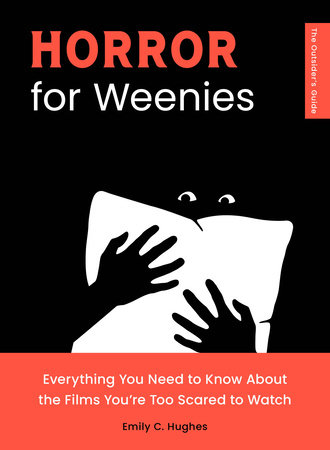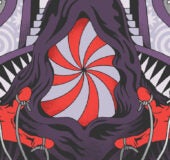INTRODUCTION
Why Horror Matters
I didn’t start habitually watching horror movies until adulthood (a fateful viewing of
Poltergeist at my tenth birthday party scarred me, and it took me a while to get past it). For many years, I would say “Oh, I’m just not a horror person” and excuse myself from dorm room movie marathons or multiplex outings to see anything scary. But I still wanted to know what happened. I didn’t want to feel more left out than I had to—plus, the invitations kept coming, so clearly my friends and peers were getting
something out of scaring themselves half to death. I’d read reviews or Wikipedia synopses or spoilery blog posts, hoping to replicate the experience—but as any good weenie knows, something is always lost when you translate a movie to text. When I read those dry descriptions, I was left wondering what I was missing. Obviously, what I was missing (quite deliberately) was the fear—but why was that an important factor? Why did people want to be scared on
purpose?
Horror fiction was ultimately the thing that brought me back around to horror cinema. The difference in medium provided me with just enough distance from the subject matter that books functioned as a sort of ad hoc form of exposure therapy. (That’s why each movie entry in this book comes with a few suggested reads—if you’re curious but can’t quite bring yourself to watch, fiction might be as useful for you as it was for me.) I found myself reaching for more intense and disturbing reads, and then eventually I realized it was time to give the moving image another try. And this time, I fucking loved it.
It’s not that I don’t get scared or disturbed by what I’m watching—I’m still a weenie at heart, if a reformed one, and if I sense a jump scare coming I’ll look anywhere other than at the screen. But coming to the genre with new eyes, I found myself fascinated by the craft of horror, the storytelling methods and cinematography tricks employed by filmmakers to evoke fear, dread, and anxiety. And this also meant I got interested in the
value of these intense emotions—the way they can provide catharsis or clarity about our day-to-day anxieties. Thinking about horror, to me, is as rewarding as watching it, if not more so, and I spend a
lot of time thinking about it.
So I feel I can now attempt to answer those big questions: What’s the big deal about horror? And why
do people want to be scared on purpose?
For starters, these aren’t exactly the same thing. Some people will tell you that if it isn’t scary, it isn’t horror, but I think that displays a paucity of imagination. What scares us is highly personal—some people run out of the room at the mere sight of a spider, for instance, while others keep tarantulas as pets. That’s why there’s no fear rating scale in this book; the things that scare me are almost certainly different from the things that scare you. And “scary” is a maddeningly imprecise word—does it mean goose bumps? A full-body flinch? A lingering sense of dread? Again, there are so many options, and the outcome is different for just about everyone. In 2018, critic Angelica Jade Bastién wrote a cri de coeur for
Vulture that argued against reducing a horror film’s merits to whether or not it scared you. Bastién posits a more expansive definition of horror, one I’ve fully embraced: it’s a genre that
explores fear, how it motivates and shapes our lives and those of the
characters we’re watching.
As individual as fear is, it still inextricably links us to each other. Every human who’s ever lived has been afraid of something, whether it’s something mundane like needles or car accidents or something fantastical like aliens or zombies. Fear is primeval, linked to our species’ ability to survive: we’re very good at identifying threats and doing our best to avoid them. In fact, we’ve done such a good job of removing ourselves from the position of prey that we now seek out fear for recreational purposes, which is pretty wild when you think about it.
There are any number of hypotheses about why people seek out the feeling of fear—a common one suggests that feeling frightened in an objectively safe setting can be exhilarating or cathartic, and while I’m sure that’s true for some people, I’m equally sure it’s not true for others. I think at the end of the day, we’re just a species of sensation seekers. Experiencing any strong emotional response is a kind of release, whether it’s a laugh, a good cry, an orgasm, or a scream. Presumably, if you’re reading this book, you’re at least a little curious about the scream.
A quick note about this book: sheerly in the interest of keeping things to a reasonable page count, I had to omit more than a few stone-cold classics (and stick to English-language films). I did my best to focus on influence over popularity; the vast majority of the movies in this book are those that founded, defined, or irrevocably changed a subgenre, the entire genre, or even the artistic landscape of cinema overall. They’re movies that subsequent works found themselves in conversation with, willingly or not. They’re also, yes, generally scary, disturbing, disgusting, unnerving, or some combination of the above.
One of the uniting features of the films covered in this book is that many of them were critically dismissed or derided when they were released. Plenty also failed financially. But a movie’s influence isn’t pegged to its box office gross or its Rotten Tomatoes score; it’s not even really related to whether or not the movie in question is any
good. Cultural staying power is more nebulous than that. The films we still talk about fifty years later have an ineffable psychological stickiness, catching on the jagged edges of our consciousness at the place where logic gives way to visceral fear. Michael Myers has lasted in our cultural memory for forty-five years because he frightens and fascinates us, not because
Halloween hit a certain box office benchmark. If a horror movie has stuck with us for years or decades, there’s something there worth examining, critics be damned. Let’s go for a ride.
Copyright © 2024 by Emily C. Hughes. All rights reserved. No part of this excerpt may be reproduced or reprinted without permission in writing from the publisher.













